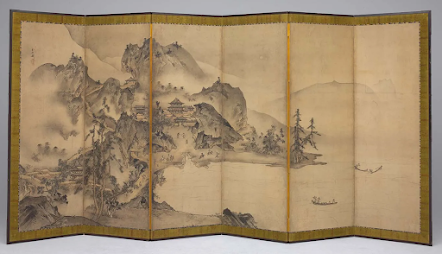Non-Western Blog, Japanese Sumi-e or suiboku-ga
Sumi-e is a Japanese/Chinese form of ink-wash painting. It comes from the term Sumi, black and -e, picture. It is also referred to as suiboku-ga. The Sumi-e masters in China influenced the suiboku-ga artists in Japan and vice versa. It came from China to Japan around 1300 from an unnamed Zen Buddhist Monk. However, the most well-known of that first generation is a person by the name of Sesshū. For this blog post, I am going to focus on the Japanese context. China and Japan have a long history of not only being linguistically connected but also influencing each other's art. The entire thought process of Sumi-e is reductionistic, it's about getting the most tree per tree, and the most brush stroke per brushstroke. Less is more. It’s about simplicity, and there is a philosophical ideal behind it of finding peace and harmony in the world around us. The idea is to capture the essence of the subject.
The first piece is by Hasegawa Tohaku called Pine Trees.
It was made when he was about fifty years old around 1600, and was attempting
to remember the place where he grew up which was apparently the Noto area in
Japan. To me Sumi-e is like a minimalistic version of impressionism, that is
also Japanese flavored, it’s the impression or essence of tree, the impression
of mist by the absence of tree. Something that is worth noting is this piece isn’t
a lot of brush strokes. It’s not busy like you would expect in western design.
Its simple. However in that simplicity is the complexity. The idea is that the
artist meditates on where to put each stroke, and that each stroke is very
thoughtfully placed. Because the over arching idea is to capture the essence of
the subject. In this case it’s the essence of tree.
I have always been fascinated by this art form, and the stark minimalism seems to capture more than what you would expect.
Sesson Shūkei is another artist from the same time period. This was made about the same time as Pine Trees which was around 1590, and this one is called Landscape of the Four Seasons. It depicts a village near the water, with trees and mountains. Something that is interesting with this work is the amount of detail you see in the work. Normally when you see a Sumi-e ink painting, it's minimalistic, the idea being to get the essence of a koi, or the essence of a bird. The entire work is focused on that one thing, capturing it with a few brush strokes as you can. In this case, what we see is the essence of a season. A season is a lot of different things going on at once. The absence is very interesting, where the brush strokes end seem to indicate large banks of mist. What is neat is that the forms of the cloud are made by the absence or fading of the ink. I have personally tried Sumi-e, and that particular technique is incredibly difficult to pull off. You have one single attempt to get the entire picture right. Sometimes like in oil painting the medium is very forgiving. If you paint something you don't like, you can scrape off the oil paint and repaint the area. What you can't do in watercolors or in ink wash is fix you mistake. You have to get it perfect on the first try, or you throw away the whole thing. If you look at the detail in this piece and the technique of using absence to suggest forms, all done correctly the first time, you get a sense of what a master this person was.
Yuki Nishimoto is a contemporary sumi-e painter, inker? Ink-est? Artist. He uses traditional techniques in new ways. So instead of making pieces that are peaceful, he uses the same techniques to capture moments of high passion, or dynamism. Like a basketball player making a slam dunk or a samurai slashing. One of the pieces that he has at the Ronin gallery is this piece, which captures how he is different and subtle by his use of line work on the woman in this work. So the line work of her body is very traditional, while the line work on her hair and robe breaks with traditional aesthetics because of how busy the lines are. The contrast creates a balance in the work. I like this work because it is simple and elegant.
References:
Jamieson, Anna. Hasegawa Tohaku: The Timeless Giant of Japanese Art. Japan Objects, 20 Mar. 2018, japanobjects.com/features/hasegawa-tohaku. Accessed 4 Aug. 2024
Tokyo 'Sumi-E' Artist Brings New Life to Traditional Art -
Nikkei Asia. 5 Dec. 2019,
asia.nikkei.com/Life-Arts/Arts/Tokyo-sumi-e-artist-brings-new-life-to-traditional-art.
Yuki Nishimoto Black and White Artwork.
www.roningallery.com/artists/yuki-nishimoto. Accessed 4 Aug. 2024.








Hi Shawn,
ReplyDeleteI think I now share your appreciation for the Sumi-e style. Thank you very much for sharing. I love the way you describe “the impression of mist by the absence of tree.” I never cared for impressionism very much, it just seemed like lazy art. I’m a luddite, I know. I apologize to the fans! The simplistic forms and the very careful and thoughtful brush strokes depicted here seem like so much more than that. This was very enlightening.